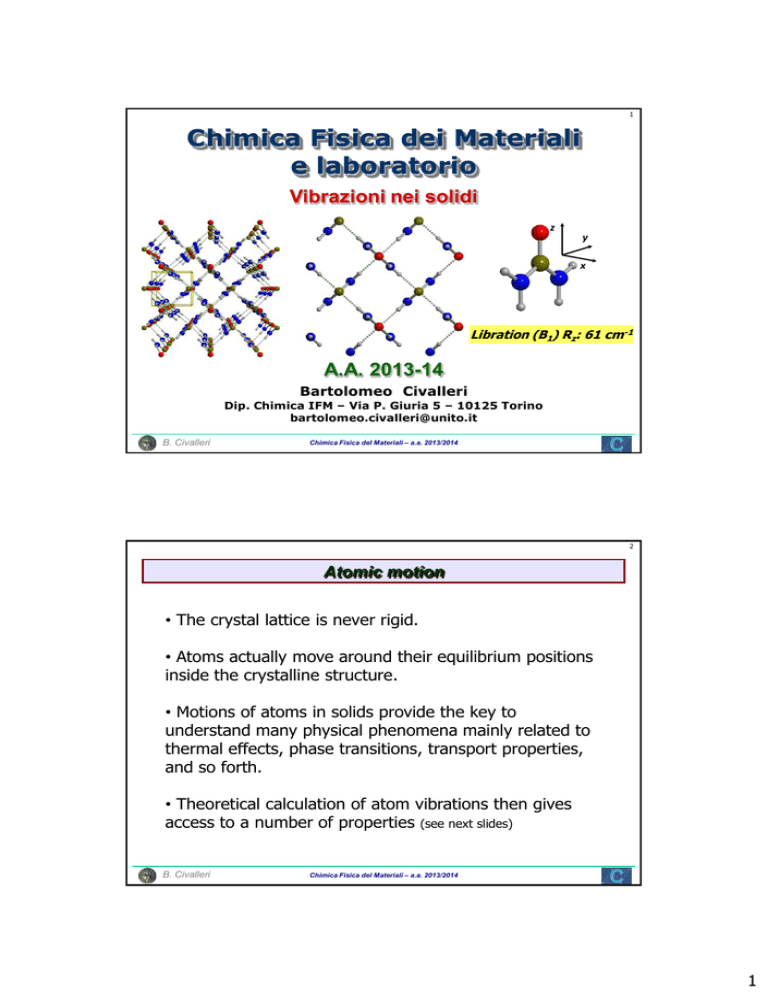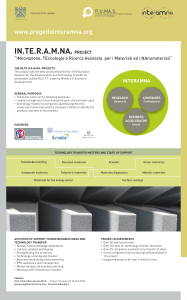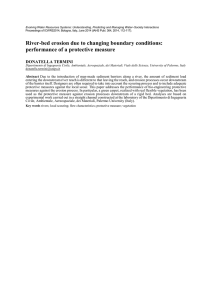Confusion Neal Stephenson
advertisement

1 Chimica Fisica dei Materiali e laboratorio Vibrazioni nei solidi z y x Libration (B1) Rz: 61 cm-1 A.A. 2013-14 Bartolomeo Civalleri Dip. Chimica IFM – Via P. Giuria 5 – 10125 Torino bartolomeo.civalleri@unito.it B. Civalleri Chimica Fisica del Materiali – a.a. 2013/2014 2 Atomic motion • The crystal lattice is never rigid. • Atoms actually move around their equilibrium positions inside the crystalline structure. • Motions of atoms in solids provide the key to understand many physical phenomena mainly related to thermal effects, phase transitions, transport properties, and so forth. • Theoretical calculation of atom vibrations then gives access to a number of properties (see next slides) B. Civalleri Chimica Fisica del Materiali – a.a. 2013/2014 1 3 Vibrations in solids: computational tools Molecular dynamics Lattice dynamics Fourier transformation of the atomic velocity autocorrelation function Taylor expansion of the potential energy surface harmonic approx. Atomic trajectories Dynamical matrix Disordered systems, high atomic mobility Crystalline systems Better at high temperature Better at low temperature Include anharmonic effects Anharmonic corrections (quasiharmonic approximation) Accuracy depends on simulation time (supercells) Thermodynamics through statistical mechanics (supercells) The two approaches provide complementary information B. Civalleri Chimica Fisica del Materiali – a.a. 2013/2014 4 LD and Potential Energy Surface Taylor expansion of the potential energy around the equilibrium configuration: E E0 1 1 1 Hij ui u j Hijk ui u j uk Hijkl ui u j uk ul ... 2 ij 3! ijk 4! ijkl Index i labels the triplet (G,t,a) with G as a translation vector of the primitive lattice, t as an atom within the primitive unit cell and a as the Cartesian coordinate of the atomic displacement u. For an equilibrium structure first-derivatives are zero (stationary point) Hij, Hijk and Hijkl are derivatives of the energy with respect to atomic displacements. They are the harmonic, cubic and quartic force constants, respectively Usually, truncated at the second order terms harmonic approximation B. Civalleri Chimica Fisica del Materiali – a.a. 2013/2014 2 5 Dynamical Matrix In lattice dynamics the central role is played by the Dynamical Matrix Dij (k ) 2E 0 G exp ik R(G) Mi M j G ui u j 0 1 Where: Mi is the mass of the atom associated to the i-th coordinate; ui is the cartesian atomic displacements of the i-th coordinate; R(G) = xi(0) - xj(G) As for electronic energy levels, translation symmetry leads to a band structure for vibrational energy levels (phonons). E.g. Silicon band structure and vDOSs B. Civalleri Chimica Fisica del Materiali – a.a. 2013/2014 6 Phonons: matter-radiation interaction • Vibrational modes can be considered as being particle-like (phonons) • Phonons can interact with radiation and matter • Phonon - Photon interaction • Optic modes at k0 • Absorption: Infrared • Scattering: Raman • Acoustic modes at k0 • Scattering: Brillouin (elastic constants) • Phonon-Neutron interaction • Inelastic Neutron Scattering (INS) B. Civalleri Optic branch Acoustic branch Chimica Fisica del Materiali – a.a. 2013/2014 3 7 Dynamical Matrix and Phonon Dispersion The dynamical matrix can be computed by using: Linear response methods Density Functional Perturbation Theory (S. Baroni, et al. Rev. Mod. Phys. (2001)) Finite displacements Numerical derivatives (supercells must be used) (CRYSTAL) A supercell calculation at G permits to map some k-points in the reciprocal space. Number and kind of k-points depends on shape and size of the supercell Dij (k ) 2E 0 G exp ik R(G) Mi M j GSC ui u j 0 1 Covalent solids: reasonable approximation, fast decay of the 2nd derivatives, interpolation schemes Ionic and semi-ionic (polar) solids: slow decay, long-range contribution important, approximate electrostatic models Results can be compared with Inelastic Neutron Scattering (INS) experiments B. Civalleri Chimica Fisica del Materiali – a.a. 2013/2014 8 Frequencies Calculation in CRYSTAL - I CRYSTAL computes vibrational frequencies at G point (k=0) 2E Dij (k 0) 0 0 Mi M j ui u j 0 1 The second-derivatives matrix is computed by numerical differentiation of the analitical first-derivatives (gradients) g i ,0 0,..., u 0j ,...,0 gi ,0 0,..., u 0j ,...,0 2E gi ,0 0 0 0 2 u 0j ui u j 0 u j 0 Special properties of the G point (k=0): • D(0) is simple to calculate • Three modes have zero frequency (acoustic branch – “translations”) • D(0) possesses the point symmetry of the crystal (factorization) • G point modes give rise to infrared and Raman spectra LO/TO splitting, relevant to polar crystals, can be also computed by using e and Z*. B. Civalleri Chimica Fisica del Materiali – a.a. 2013/2014 4 9 Frequencies Calculation in CRYSTAL - II In polar crystals, long range Coulomb effects give rise to macroscopic electric fields for longitudinal optic modes (LO) at k0 (LO-TO splitting): Dij (k 0) Dijan (k 0) Dijna (k 0) LO-TO splitting is computed by including a non-analytical term which depends on the electronic dielectric tensor e and on the Born effective charge tensor associated to each atom. 4 k Z i k Z D (k 0) V k ε k na ij j Where: V is the volume of the unit cell; Z* is the Born effective-charge tensor (analogous to the molecular GAPT charges); e is the electronic dielectric-constant tensor (CPHF/KS, see Bernasconi’s lecture) All those quantities can be computed by CRYSTAL B. Civalleri Chimica Fisica del Materiali – a.a. 2013/2014 10 The Born tensor The atomic Born tensors are key quantities for : calculation of the IR intensities calculation of the static (low-frequency) dielectric tensor, e0 calculation of the Longitudinal Optical (LO) modes They are defined, in the cartesian basis, as (for atom a): Za* ij ua j E i i ua j *i=component of an applied external field **μ=cell dipole moment (polarization per unit cell) B. Civalleri Chimica Fisica del Materiali – a.a. 2013/2014 5 11 The IR intensity - II Ap d p Qp The IR intensity of the p-th mode: Za* ij The Born charge tensor: ua j E i 2 i u aj 2 Ap d p Z p, j *dp=degeneracy of the p-th mode B. Civalleri Chimica Fisica del Materiali – a.a. 2013/2014 12 The static dielectric constant ε0 → static (low-frequency) dielectric constant ε → electronic (high-frequency) dielectric constant ωp → p-th frequency eigenvalue Ω → unit cell volume 4 e e 0 ij ij 4 e ii0 e ii B. Civalleri Z p,i Z p, j Ionic contribution p p 2 Z p,i p p Only one component for each Zp is non null Chimica Fisica del Materiali – a.a. 2013/2014 6 Reflectance Spectrum R e 1 2 e 1 4 e ij e ij Z p,i Z p, j p 2 i p p Spessartine (garnet) Mn3Al2 (SiO4)3 Spessartine …… Rcalc ___ Rexp 14 Applications of Lattice Dynamics - I Interpretation of vibrational spectra analysis of the normal modes assignment visualization/animations symmetry analysis IR/Raman active/inactive isotopic substitution Thermodynamics calculation of thermodynamic functions phonon density of state pressure- and temperature-dependent properties free energy harmonic approximation, quasi-harmonic approximation simple models Equations of state (p-V-T) phase diagrams phase stability phase transitions pt solid-state reactions kinetics of transformation simple models B. Civalleri Chimica Fisica del Materiali – a.a. 2013/2014 7 15 Applications of Lattice Dynamics - II Calculation of the Atomic Displacement Parameters (ADPs) computed from the eigeinvectors of the dynamical matrix anisotropic thermal ellipsoids diffraction data thermal motion corrections e.g. bond distances Debye-Waller thermal factors dynamic X-ray structure factors related to the intensity of Inelastic Neutron Scattering measurements Characterization of the PES structure stability no imaginary frequencies characterization of minima, transition states, higher-order saddle points Isotopic equilibria isotope enrichment in minerals Ab-initio derived semiempirical interatomic potentials basic information: E, X, g, i, Cij, B, ... construction (benchmark) of new (existing) interatomic potentials transfer from the electronic to the atomic scale better transferability (?) B. Civalleri Chimica Fisica del Materiali – a.a. 2013/2014 16 Thermodynamics Vibrational partition function Z Zi i i CV ,T exp(hi 2kBT ) exp(hi kBT ) 1 R 2 ln Z T 2 1 T 2 V G ,T Est pV RT ln Z S ,T R ln Z RT ln Z T V Phonon density of state g k dk k dk i BZ f T max i i f ,T g d e.g. CV T 0 B. Civalleri p ip max ; g d 1 CV ,T g d 0 Chimica Fisica del Materiali – a.a. 2013/2014 8 17 Thermodynamic functions: Pyrope Specific Heat CV Entropy M. Catti, F. Pascale and R. Dovesi, unpublished B. Civalleri Chimica Fisica del Materiali – a.a. 2013/2014 From lattice dynamics to MSDs and ADPs 18 The atomic Mean Square Displacement (MSD) tensors (symmetric 3x3 tensor) can be computed as Batom (q ) 1 Mq E j k k e q | jk e q | jk jk T 2 j • e(q|j,k) corresponds to the atomic displacement (eigenvector component) of the atom q in the mode j along the wavevector k. • Ej(k) is the energy of the vibrational mode 1 1 E j k j k 2 exp j k / kBT 1 Atomic Anisotropic Displacement Parameters (ADPs, U(q)) can be readily obtained from Batom(q) tensors They can be compared with ADPs from X-ray or neutron diffraction Visualized in terms of thermal ellipsoids B. Civalleri Chimica Fisica del Materiali – a.a. 2013/2014 9 19 From internal to external modes: supercell approach B3LYP/6-31G(d,p) ADPs strongly depend on the supercell size A supercell of 2x2x2 size gives a reasonable agreement with experiment 0.39 3.36 0.98 0.13 Isotropic MSD (Å2) ADPs of N atom show a great variability, with a large contribution from low frequency modes 0.96 123 K Equal-probability ellipsoids (50%) B. Civalleri Wavenumbers (cm-1) Chimica Fisica del Materiali – a.a. 2013/2014 20 ADPs of Benzene, Urotropine and L-Alanine B3LYP/6-31G(d,p) [2x2x2] 15 K 0.43 0.83 0.53 1.38 23 K 15 K 0.38 0.46 0.37 0.06 0.56 0.53 0.24 0.68 0.17 Equal-probability ellipsoids (50%) with similarity index B. Civalleri 0.31 0.22 Equal-probability ellipsoids (75%) Chimica Fisica del Materiali – a.a. 2013/2014 10 21 Accuracy: DFT methods vs experiment Less than 20 cm-1 • Dataset of 134 vibrational frequencies (IR and Raman data) • 11 DFT methods: LDA, GGA (standard and for solids), hybrids • Hybrid methods, in particular, B3LYP and WC1LYP give the lowest MAD MAD (cm -1 ) • Four different systems: pyrope, forsterite, quartz and alumina 18 16 14 12 10 8 6 4 2 0 Demichelis, Civalleri, Ferrabone, Dovesi, IJQC (2010) B. Civalleri Chimica Fisica del Materiali – a.a. 2013/2014 22 Interpretation of vibrational spectra How to do that? Scaling factors: Comparison between computed and experimental frequencies Symmetry analysis IR/Raman active/inactive Direction of transition moment vectors (TMV) (IR active modes) Analysis of the normal modes assignment visualization/animations Isotopic substitution Known problems: Anharmonicity (in particular: H-X vibrations and low-frequency modes) Combination of modes: overtones and Fermi mixing Approximations in the structural model Deficiencies of the adopted level of theory B. Civalleri Chimica Fisica del Materiali – a.a. 2013/2014 11 23 Polystyrene: trans-Planar and s(2/1)2 Helix Trans-planar s(2/1)2 Helix Pm2a (C2v) P2122 (D2h) F. J. Torres, B. Civalleri, C. Pisani, P. Musto, A. R. Albunia, G. Guerra, J. Phys. Chem. B 111 (2007) 6327 A. R. Albunia, P. Rizzo, G. Guerra, J. Torres, B. Civalleri, C. M. Zicovich-Wilson, Macromolecules 40 (2007) 3895 F. J. Torres, B. Civalleri, A. Meyer, P. Musto, A. R. Albunia, P. Rizzo, G. Guerra, J. Phys. Chem. B 113 (2007) 5059 B. Civalleri Chimica Fisica del Materiali – a.a. 2013/2014 24 IR spectrum of trans-planar sPS: spectrum B3LYP/6-31G(d,p) scaled frequencies (scale factor: 0.9614) 1452 906 1379 840 a am Absorbance 1440 1380 1340 1300 1260 1220 920 880 840 Calc. calc a Exp. am 3000 1500 1000 -1 500 Wavenumber (cm ) IR intensities as % fraction of the max. computed intensity of 89 km/mol ( = 681 cm−1). Lorentzian profile was used with a FWMH of 10 cm -1 B. Civalleri Chimica Fisica del Materiali – a.a. 2013/2014 12 25 Trans-planar polystyrene: normal modes animation Animations of the normal modes: http://www.crystal.unito.it/vibs/alpha-ps/ B3LYP/6-31G(d,p) scaled frequencies (scale factor: 0.9614) B. Civalleri Main spectral regions: 3200 - 2800 cm-1 n(C-H) aromatic and alkyl groups 1600 - 1350 cm-1 phenyl and alkyl groups: n(CC) (1575 cm-1) and (CH) 1350 - 1000 cm-1 phenyl (CH) and alkyl (CH) (1329 cm-1) 1000 - 500 cm-1 deformation aromatic rings and CH groups (976 cm-1) below 500 cm-1 collective vibrations (torsions) (70 cm-1) Chimica Fisica del Materiali – a.a. 2013/2014 26 Trans-planar sPS: exp. vs calc. Full assignment of 50 IR and Raman frequencies B. Civalleri Chimica Fisica del Materiali – a.a. 2013/2014 13 27 sPS s(2/1)2 helical chain: Transition moment vectors BORN TENSOR COMPONENTS IN THE NORMAL MODE BASIS MODE 1 2 3 4 5 6 7 8 9 10 11 12 13 14 15 16 17 18 19 20 ... 187 188 189 190 191 192 X -0.00501 0.00000 0.00000 0.00087 0.00000 0.00000 -0.00950 0.00000 0.01023 0.00000 0.00000 0.00000 0.00000 0.00000 0.00000 -0.00235 -0.01972 0.00000 0.00000 0.00000 Y 0.00000 0.00000 -0.00212 0.00000 -0.00049 0.00000 0.00000 0.00000 0.00000 0.00000 0.00000 0.00166 0.00000 -0.00726 0.00000 0.00000 0.00000 0.00000 0.00000 0.00000 Z 0.00000 -0.00339 0.00000 0.00000 0.00000 0.00000 0.00000 0.00523 0.00000 -0.00408 0.00000 0.00000 -0.00651 0.00000 0.00000 0.00000 0.00000 0.00000 0.00000 0.00019 0.00000 0.00000 0.00000 -0.13278 z 0.00000 0.00000 -0.15817 0.00000 0.00000 0.00000 0.00000 -0.19065 0.00000 0.00000 0.00000 0.00000 -0.21353 0.00000 B. Civalleri x In CRYSTAL polymers are oriented along the x-axis. Therefore: x calc. = z exp. y calc. = x exp. z calc. = y exp. y Chimica Fisica del Materiali – a.a. 2013/2014 28 sPS s(2/1)2 helical chain: Transition moment vectors calc TMVcalc Symmetry 1383 y B2u 1366 z B1u 1358 z B1u 1329 x B3u 1320 x B3u 1231 z B1u 1167 y B2u 1098 z B1u 1078 x B3u 969 x B3u 934 z B1u 921 x B3u 853 z B1u 769 x B3u 765 z B1u 743 x B3u 594 x B3u 577 y B2u 566 z B1u 540 x B3u 530 z B1u 498 x B3u FTIR spectra: (A) of an unoriented form film of s-PS; (B) spectrum A, after subtraction of the spectrum of the amorphous phase; (C) ab-initio simulated spectrum of a s(2/1)2 helix of s-PS x z Absorbance nexp TMVexp 1378 Y 1364 Z 1354 Z 1329 X 1320 X 1232 Z 1169 Y 1117 Z 1078 X 977 X 944 Z 934 X 858 Z 780 X 766 Z 750 X 601 X 581 Y 572 Z 548 X 534 Z 503 X z A +am x z y xx x y x x z z y 1400 xx x z x x x y 1000 800 -1 z x B z y x zx 1200 y 600 xz x C calc 400 Wavenumber (cm ) Frequencies scaled by 0.972. Only the most relevant spectral region (1400 - 500 cm-1) is shown B. Civalleri Chimica Fisica del Materiali – a.a. 2013/2014 14 29 Isotopic substitution and isotopic shift Dij (k 0) 2E 0 G Mi M j G ui u j 0 1 • As a tool for the assignment of the modes and for the interpretation of the spectrum • One atom at a time (e.g. 29Al for 27Al) (experimental data available for comparison) • In some cases also infinite mass: Advantages with respect to subunits investigated with clusters a) the atoms move in the field created by the infinite system. b) and in the presence of the other atoms c) and the hessian matrix is the correct one B. Civalleri Chimica Fisica del Materiali – a.a. 2013/2014 30 Vibrational frequencies of Calcite (CaCO3) Dn(exp.t) 13C Isotopic substitution 18O 62 B3LYP 28÷27 12÷8 9 15 38 16 37 Exp. Data: P. Gillet, et al. Geochim. Cosmochim. Acta 60 (1996) 3471; M.E. Böttcher, et al. Solid State Ion. 101-103 (1997) 1379 B. Civalleri Chimica Fisica del Materiali – a.a. 2013/2014 15 31 Anharmonicity: the problem of X-H modes X-H stretching modes are highly anharmonic. How to deal with that? X-H stretching fully decoupled from any other normal modes exe=(2 01- 02) / 2 A wide range (0.5 Å) of X-H distances must be explored to properly evaluate E1 and E2 E2 E1 E0 02 01 Direct comparison with experiment for fundamental frequency, first overtone and anharmonicity constant (ANHARM) B. Civalleri Chimica Fisica del Materiali – a.a. 2013/2014 32 Isolated OH groups in crystals: model structures/1 H O M Edingtonite surface Chabazite M=Mg Brucite M=Ca Portlandite All calculations with 6-31G(d,p) basis set B. Civalleri Chimica Fisica del Materiali – a.a. 2013/2014 16 33 B3LYP vs experimental OH frequencies 01 Raman 01 IR Calc 3663 3694 Exp 3654 3698 Calc 3637 3650 Exp 3620 3645 Calc -- 3742 Exp -- 3747 Calc -- 3648 System Brucite Portlandite Edingtonite Chabazite Exp B. Civalleri 3603 Chimica Fisica del Materiali – a.a. 2013/2014 Hydroxylated amorphous silica surfaces B3LYP, P1, 200 atoms, 3000 AO 13 Å A300/423 K B3LYP 13 Å 3900 MCM-41 mesoporous material model 3600 3300 3000 B3LYP, P1, 580 atoms, 7800 AO MTS/423 K 41 Å B3LYP unit cell 3800 3600 3400 3200 3000 17





